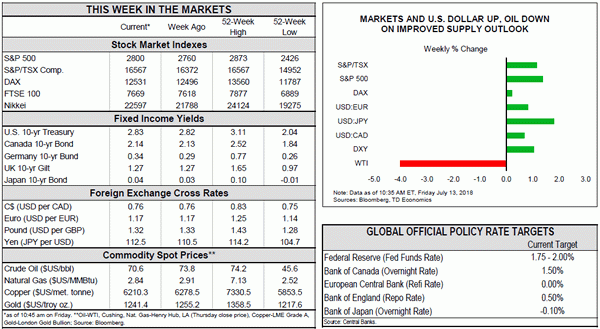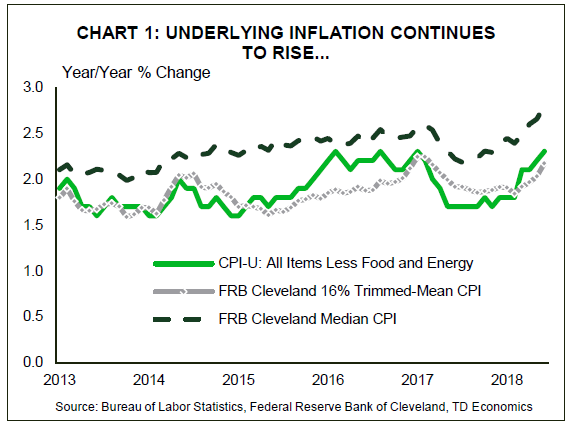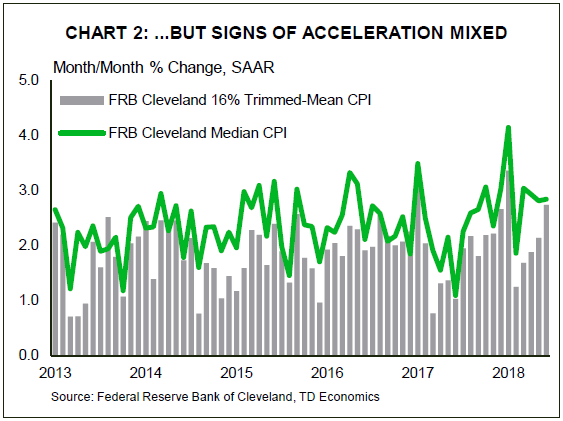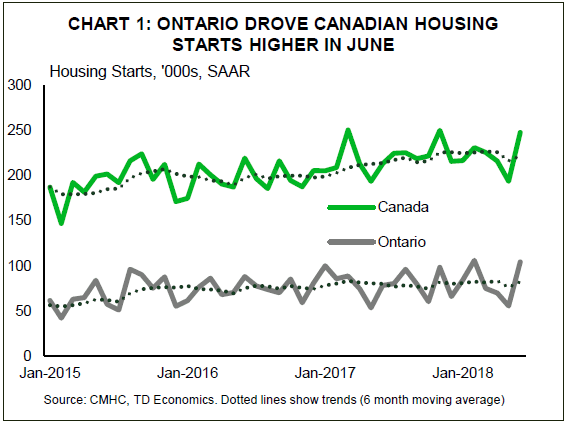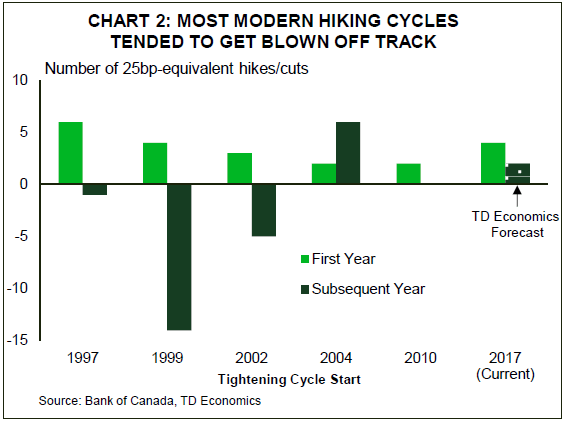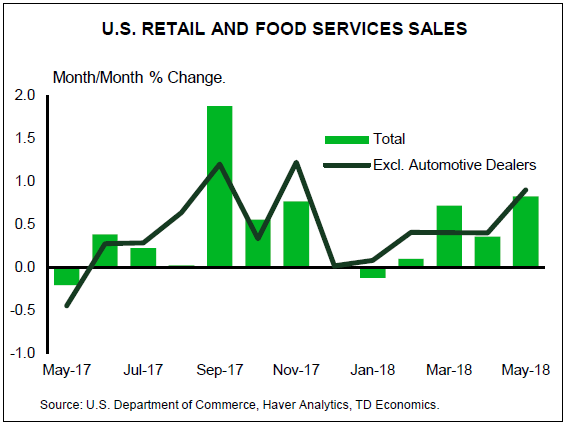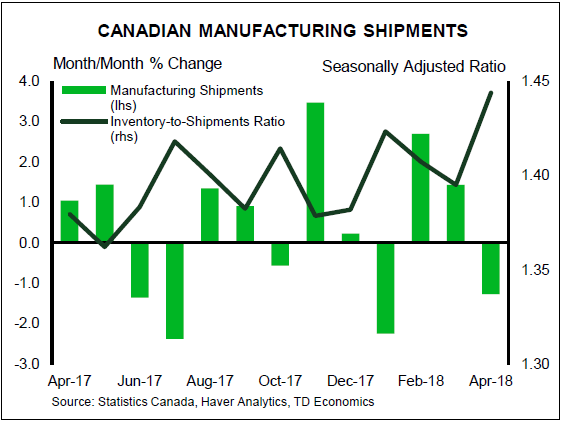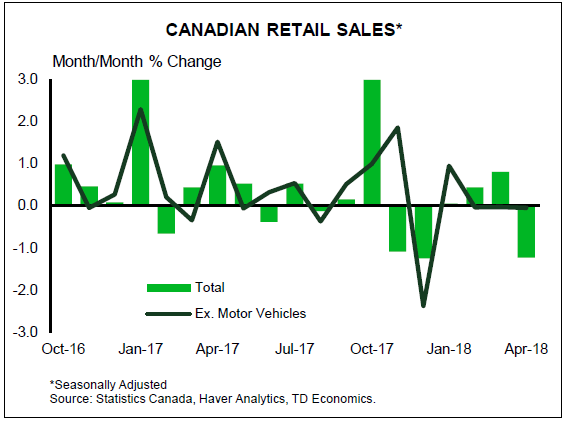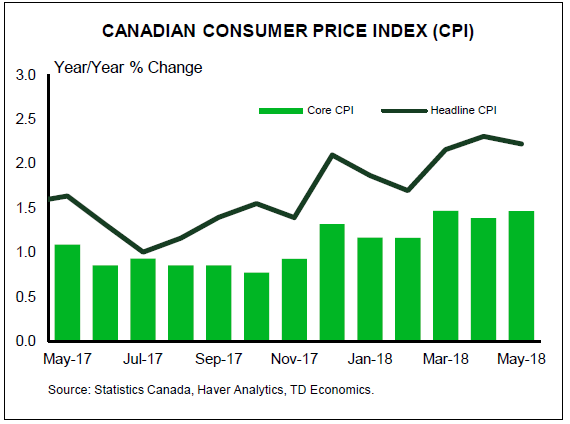U.S. Highlights
- For the second week in a row, action on Chinese import tariffs dominated the economic news, but markets remained positive overall, likely reflecting relief that oil prices have come off their recent highs.
- Since China retaliated to the first salvo of U.S. tariffs, the U.S. is moving ahead with the process to impose a further 10% tariffs on $200 bn of Chinese goods, after a two-month consultation period. Tariffs will make the Fed’s job of reading inflation signals more difficult.
- So far June CPI data showed inflation rising steadily, as expected. But, it is still too early to see much impact from tariffs in consumer prices
Canadian Highlights
- Canadian markets had a mixed week, as the TSX composite index marked new highs despite soft energy prices that weighed on the loonie.
- The Bank of Canada hiked its key policy rate to 1.50% (from 1.25%). Despite unabated risks facing the economy, the accompanying communication struck an upbeat tone.
- More rate hikes are coming, but until there is meaningful clarity on the international trade environment and household balance sheets, they are likely to be few and far between.
U.S. – Tariffs Make Fed’s Job Tougher
For the second week in a row, action on Chinese import tariffs dominated the economic news, in what was a relatively quiet week for data. Markets remained positive overall, despite the headlines, likely reflecting relief that oil prices have come off their recent highs.
President Trump had previously threatened that if China retaliated to the first tranche of U.S. tariffs, he would order further 10% tariffs on $200 bn worth of Chinese imports. China indeed retaliated, and so this week the U.S. Trade Representative (USTR) started the process of making good on this threat by publishing a list of goods which would be subject to a 10% tariff. To be clear, these tariffs are not immediate; they need to go through a two-month process before being enacted. The USTR will hold a public consultation period ending on August 30th.
So far, China has held off on announcing knee-jerk retaliatory tariffs. It remains to be seen what steps China might take. In the meantime, this creates uncertainty for businesses, and likely further volatility in the trade data, as businesses attempt to ramp up shipments ahead of the potential tariffs. In this way, and in prices for many commodities, even potential tariffs have an impact on real economic activity.
These tariffs will raise input prices for many American businesses, but the extent to which they are passed on to consumer prices will depend on the competitive environment of the industry. If businesses can’t pass on price increases to their customers (for fear of losing too much market share), they may have to cut costs by reducing staff or planned investments. Both of these actions will crimp growth in the overall economy. If tariffs are fully passed on to consumers you get higher inflation, and slower growth by a different channel. The federal government may mitigate the negative impact by funneling the tax revenues back into the economy.
For the second week in a row, action on Chinese import tariffs dominated the economic news, in what was a relatively quiet week for data. Markets remained positive overall, despite the headlines, likely reflecting relief that oil prices have come off their recent highs.
In a perfect world, the Fed will look through one-time price increases caused by tariffs. However, if tariffs are placed on a wide variety of goods further up the supply chain, it makes it difficult to disentangle how much inflation is due to a hot economy, and how much is the result of tariffs. That raises the risk the Fed misinterprets the inflation signal.
This suggests the Fed is likely to be very cautious. This week’s June CPI data was too early to pick out evidence of import tariffs. Overall the data showed yr/yr inflation continued to rise as expected, reaching 2.9% (Chart 1). Core inflation was 2.3% yr/yr, having risen steadily for the past year. The upswing in annual inflation in part reflects comparisons to low readings last year. Monthly increases look steadier (Chart 2), with little acceleration in June.
Next week Chair Powell testifies before Congress on the economy. It should have been a straightforward good news story of a strong economy, with inflation rising in a non-threatening way and gradual increases in interest rates. Now, he is likely to face questions on the impacts of tariffs, which are both uncertain and hard to forecast.
Canada – Poloz Pulls the Trigger, Path Forward Still Cloudy
Who said summer was boring? There was lots of excitement to be had this week. The Bank of Canada’s rate hike on Wednesday sent the loonie higher in its immediate aftermath. The gain was not to last however, as oil prices fell later that day, with the benchmark WTI contract set to end the week down about U.S. $4 per barrel. Oil outweighed rates when it came to the loonie, which looks set to close out the week below 76 cents U.S. at the time of writing – a drop of about half a cent from Monday’s market open. Despite all of these developments, the S&P/TSX, while choppy, made an all-time high on Tuesday, followed by several through the day on Thursday.
On the economic front, Tuesday saw housing starts data for June, which saw activity bounce back to hit 248k (at an annual pace). Driving the gain was a sizeable increase in multi-family activity, with Ontario in the driver’s seat (Chart 1). How much of the elevated activity of late can be put down to condo pre-sales during earlier, hotter markets remains to be seen, but decent building permit figures suggest that builders will keep breaking ground.
Of course, the main event was the Bank of Canada’s rate decision on Wednesday, where the policy interest rate was taken higher for a fourth time in a year, to 1.50%. Nearly all of the communication from the Bank of Canada struck an upbeat tone and the growth outlook was upgraded, somewhat surprising given the risks to the Canadian economy. The improved view on growth came despite the incorporation of additional drag on trade and investment due to trade policy uncertainty, suggesting that the Bank sees a robust underlying economy.
In a normal world, this sort of communication and outlook would be a signal that more tightening is imminent. Additional rate hikes are likely, but will probably be well spaced out. The speed limiter comes down to two key factors. Domestically, the sensitivity of highly indebted households to rate hikes remains an open question. Our research suggests that each rate hike, all else equal, has about a 30% larger impact on household finances than a decade earlier. This appears to be borne out in the credit and consumer spending data, which have decelerated markedly this year, but with mortgage rule changes muddying the water, it is hard to be 100% sure.
The other factor is President Trump. The President’s visit to Europe and the UK this week provided more evidence of the scant regard in which he appears to hold longstanding relationships, trade or otherwise. We still have little reason to expect a speedy resolution of NAFTA negotiations, and at the same time, U.S.-China trade tensions continue to heat up. Extreme events, such as a NAFTA dissolution or auto tariffs, fortunately remain outside risks, but if one treats monetary policy as a risk setting exercise – as Poloz has indicated he does – these risks surely must be taken into account. Indeed, the history of the Bank of Canada under inflation targeting has largely been one of rate tightening cycles blown off course by external events (Chart 2). Monetary policy cannot address structural factors, but it can help the adjustment. So until we have more resolution on the external environment (and a better picture of household balance sheet dynamics), caution should rule the day.
U.S.: Upcoming Key Economic Releases
U.S. Retail Sales – June
Release Date: July 16, 2018
Previous: 0.8%, ex-auto: 0.9%, control group: 0.5%
TD Forecast: 0.4%, ex-auto 0.2%, control group: 0.4%
Consensus: 0.5%, ex-auto 0.4%, control group: 0.4%
We look for a 0.4% rise in both headline and core retail sales, as core sales moderate after a long string of strong increases. This should still leave Q2 real consumer spending tracking near a 2.5% pace.
Canada: Upcoming Key Economic Releases
Canadian Manufacturing Sales – May
Release Date: July 17, 2018
Previous: -1.3% m/m
TD Forecast: 0.5% m/m
Consensus: N/A
TD looks for manufacturing sales to post a 0.5% advance for May. Energy production should post a partial rebound after refinery shutdowns led to an 11% pullback in petroleum shipments for April. However, this will be offset by weaker auto production amid supply chain disruptions, which shaved 5% off May exports. Outside these two industries we look for a broad advance in activity, consistent with robust survey data. However, real manufacturing sales should see little change after accounting for the rise in factory prices.
Canadian Retail Sales – May
Release Date: July 20, 2018
Previous: -1.2%, ex-auto: -0.1%
TD Forecast: 1.3%, ex-auto: 0.5%
Consensus: N/A
Retail sales should rebound by 1.3% in May, with motor vehicle sales leading the advance after severe weather led to a sharp pullback in April. As a result, sales ex-autos should post a more modest 0.5% gain Motor vehicle sales are unlikely to recover fully from April given a steady deceleration in credit growth, but should nonetheless provide a significant tailwind to the headline print. Gasoline station sales will also make a positive contribution on higher prices, while volumes should benefit from the return to more favourable weather and driving conditions. Outside of these two components we look for a moderate expansion in retail activity as the healthy labour market and early signs of stabilization in housing allow consumers to loosen their purse strings. Meanwhile, real retail sales should come in near the nominal print owing to the modest increase in consumer prices for May.
Canadian Consumer Price Index – June
Release Date: July 20, 2018
Previous: 0.1% m/m, 2.2% y/y, Index: 133.4
TD Forecast: 0.0% m/m, 2.3% y/y, Index: 133.4
Consensus: N/A
We expect headline CPI to inch higher to 2.3% y/y, with prices flat on the month. Energy prices were lower on the month on a pullback in gasoline prices but will be a net boost on a y/y basis and exchange rate pass-through is also a tailwind. In general we view risks to the report as skewed to the upside after protracted weakness in core categories. CPIXFE in particular registered flat to lower m/m reads over the prior two months partly on one-offs. As a result, exclusion based measures will continue to underperform the BoC core measures, which remain near 2.0%. Looking ahead, we expect CPI to be range bound in the low 2s into Q3.




